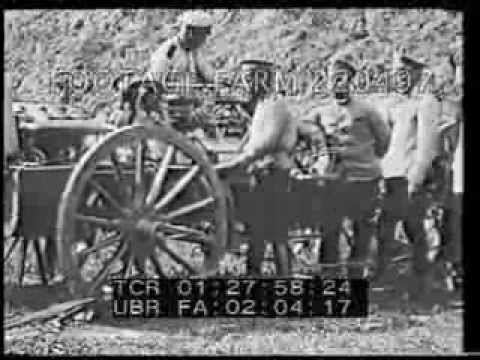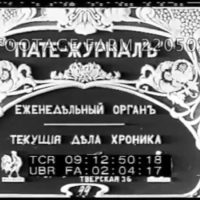
Related

1911 Russia Various 220496-06 | Footage Farm

1912 Russia Various 220496-04 | Footage Farm

1914 Russian various 220502-11 | Footage Farm

WWI - Newsreel Excerpts 220766-03 | Footage Farm

1912 - Russian Tsar Nicholas & Family Reviewing Troops 220497-04 | Footage Farm

1910s - Russian Sports Events 220498-09 | Footage Farm

Early Russian 220503-03 | Footage Farm

1914 - WWI, Preparations in France & Russia 220494 09 | Footage Farm

Russian Revolution Scenes 220675-01 | Footage Farm
1912 - Newsreel Footage Pt2/2 220497-07 | Footage Farm
Summary
If you wish to acquire broadcast quality material of this reel or want to know more about our Public Domain collection, contact us at info@footagefarm.co.uk
Russian Inter-title: Livadia (Crimea) Tsar Nicholas II reviews troops.
01:27:27 Officers on horseback leading marching band & soldiers thru village. 52 Vilensky regiment (?). Horse pulled medical wagons past.
01:27:52 Russian troops beside artillery (?). Tsar & others on horse back watching & reviewing w/ large flag past troops.
01:28:10 Unid VIPs w/ French (?) flags marching past troops (Australian?) w/ rifles; or Boy Scouts w/ walking sticks?.
01:28:17 Russian infantrymen in France (?)
01:28:22 Russian Inter-title: New York - Artillery training at Forts Adams and Fort Weatherill, Newport, Rhode Island. Explosions near floating targets.
01:28:36 [Dam Collapse Aftermath] Broken concrete against hillside, stream running past. Large destroyed buildings & workers clearing rubble. Collapsed houses on riverbank. NOTE: May be Austin, Pennsylvania collapse 30Sep11 aftermath.
01:29:06 Russian Inter-title: Berlin - Emperor at maneuvers.
01:29:10 Posing on horseback w/ others. Troops marching past in pointed-helmets. Troops under roadside trees; past in large trucks.
01:29:24 King of Serbia leaving hospital w/ nurses
Pre-WW1; Pre-WW2; 1910s Newsreels; Royalty; Diplomacy;
There were special court cameramen and photographers who captured the daily life of the Romanov family. The Company of von Gun filmed the Tsar, and with the permission of the Ministry of the Court, showed these films in movie theatres beginning in 1907. Before the February 1917 Revolution, the von Gun Company was the main provider of the Tsar's chronicles in the Russian film industry. After 1907 other filmmakers were permitted to film the Royal family, including A. Drankov, V. Bulla (the elder), Khanzhonkov Company, Pate Company, and others. Before the beginning of World War I a newsreel became popular capturing military parades, holidays, reviews and drills. Many are devoted to the Fleet. They document everyday life of the Baltic Sea and Black Sea squadrons. Some of the newsreels document the fire of the Maly Theatre in Moscow, mass gymnastics, auto and motor races, zoos and animal preserves, and the life of peoples of the Russian Empire. The objects of filming were political and cultural figures, the construction of warships, the Moscow flood, the testing of new agricultural equipment and the oil industry in Baku. There are also films showing the towns of Russia, etc. During World War I, cameramen captured events on all fronts. Before 1915, the exclusive rights to film battles belonged to the Film Department of the Skobelev Committee. The Skobelev Committee of the Assistance to the Wounded Soldiers of the General Staff was founded in November 1904 as a public organization. By the order of the Scobelev Committee many cameramen filmed the events of the World War I, such as Englishman Arcol (representative of Pate Company, filmed on South-Western and Caucasus fronts), cameramen E.D. Dored (represented American companies) and P.V. Ermolov, (filmed events on Caucasus front); P.K. Novitskiy (Gomount Company), N.M. Toporkov, K.E. von Gan, A.K. Gan-Jagelskiy, made filming in the General Headquarters. Other cameramen such as: A. G Lemberg, S, Zebel, Trushe, etc. also worked at the fronts. Cameramen filmed the war not only on the fronts but also from the rear. Since the first month of the war until 1917 the Scobelev Committee produced about 70 newsreels. From 1914 to 1915 cameramen of the Scobelev Committee produced 21 series of the newsreel "Russian Military Chronicle". The materials of this newsreel were used many times for the separate films made by Scobelev Committee and other film companies. Read more at: http://www.pbs.org/redfiles/rao/archives/rgakfd/textind10.html
